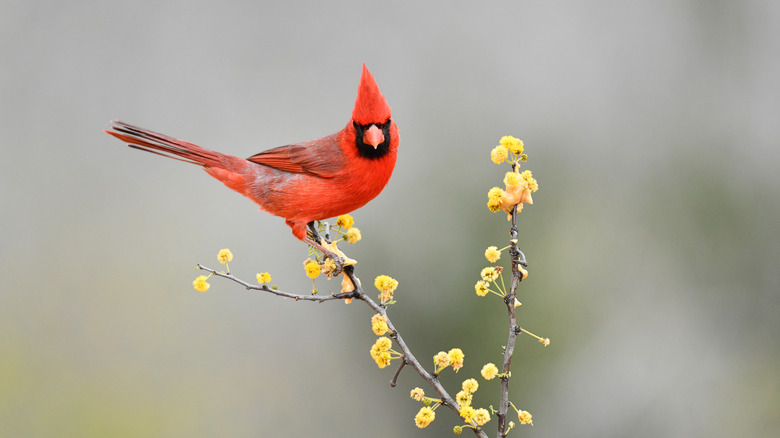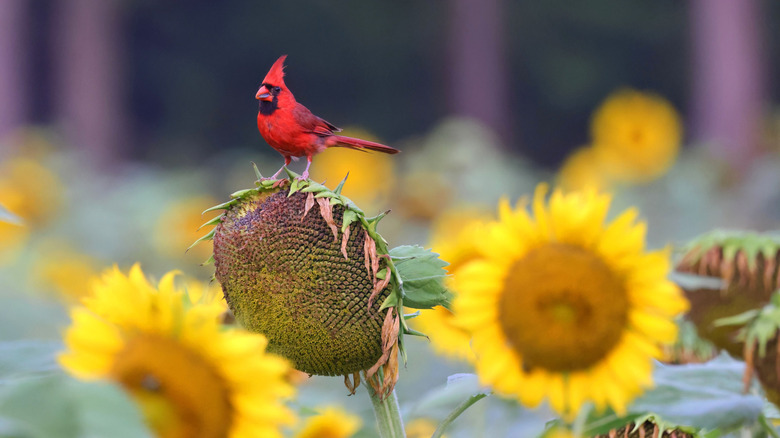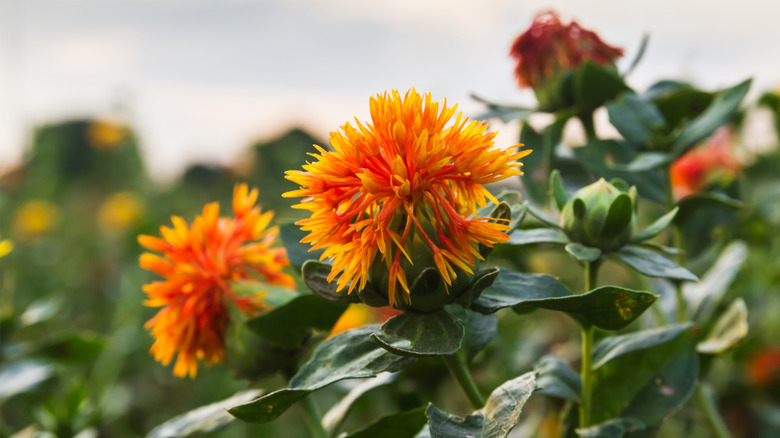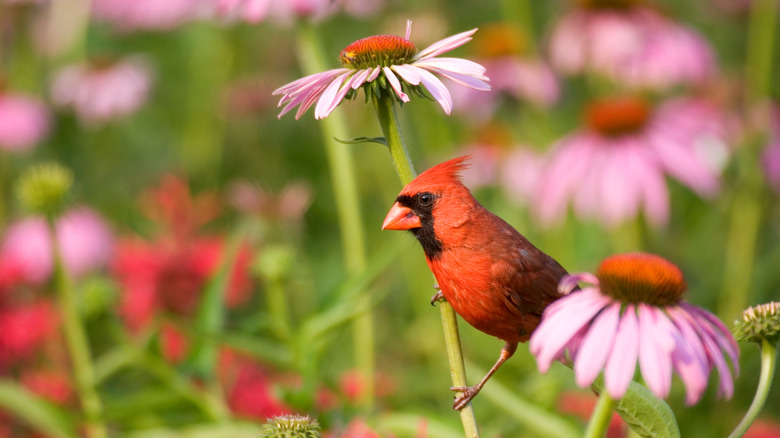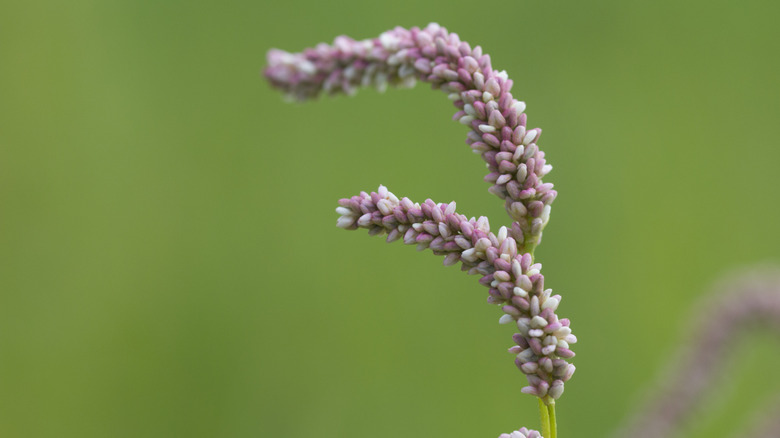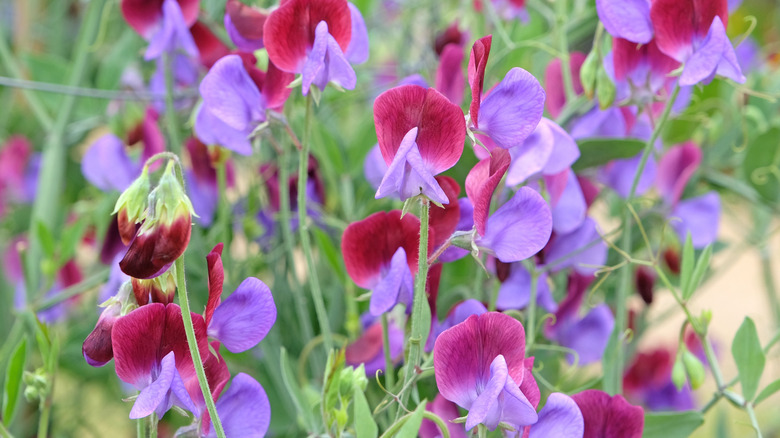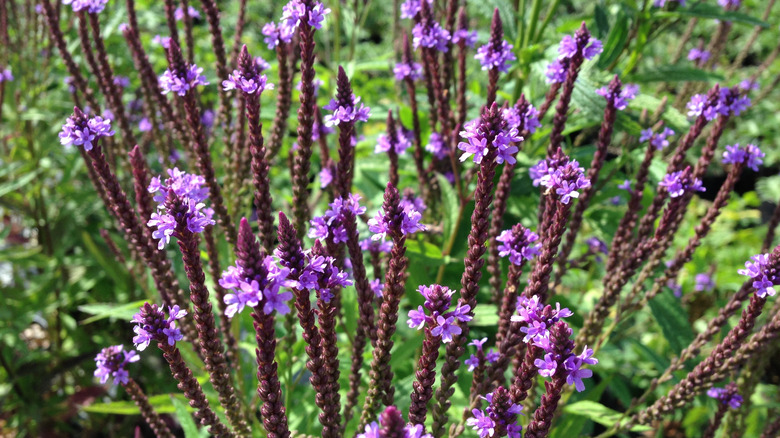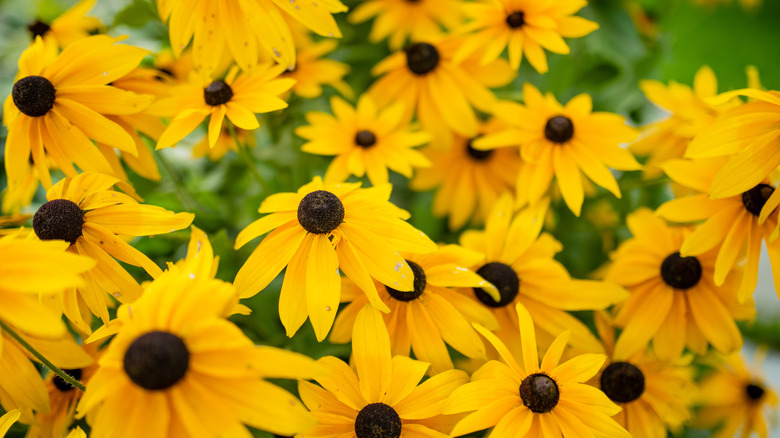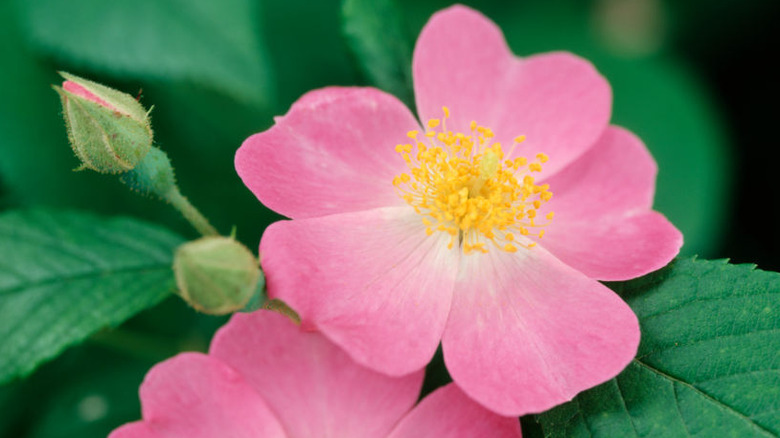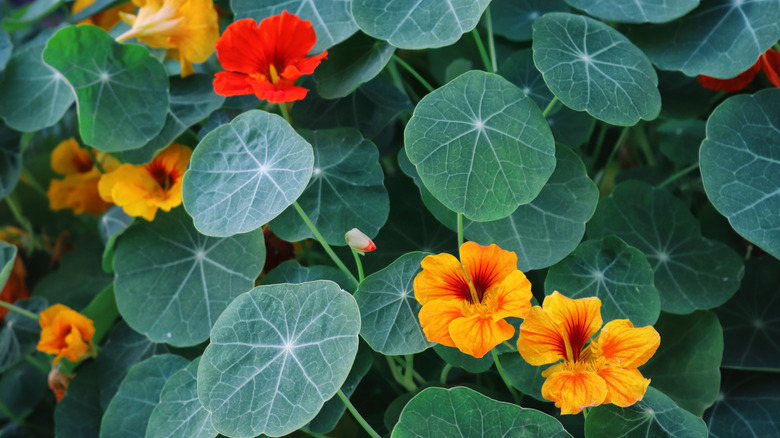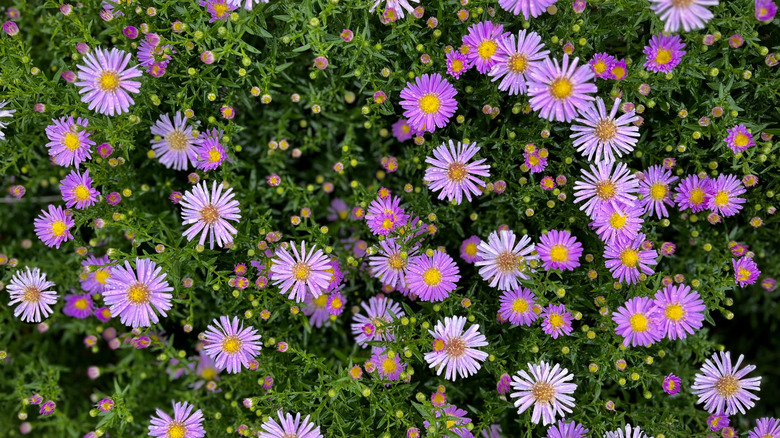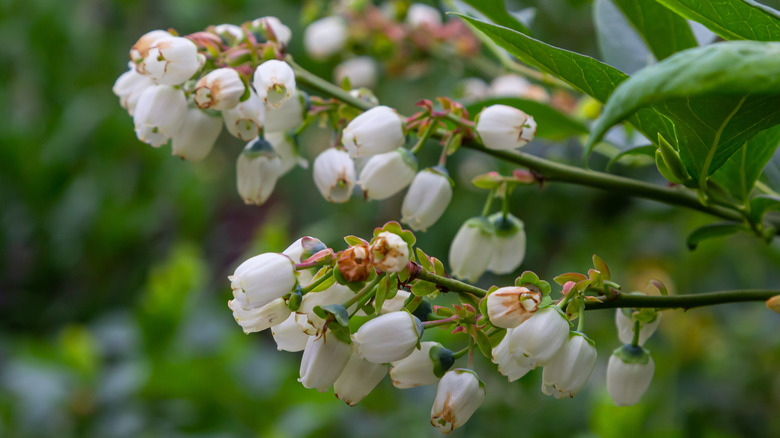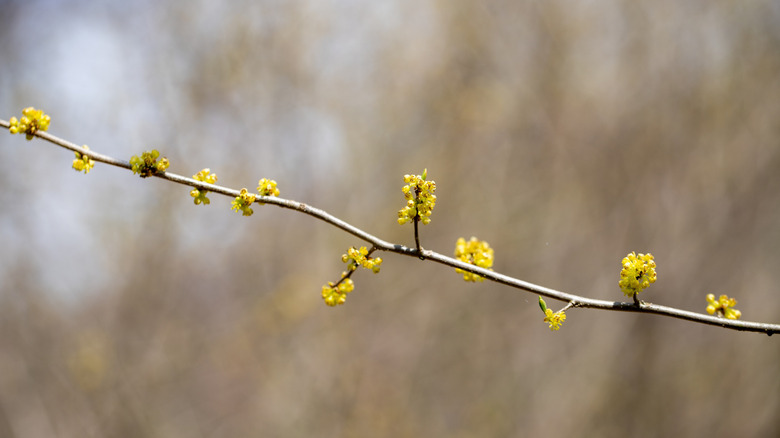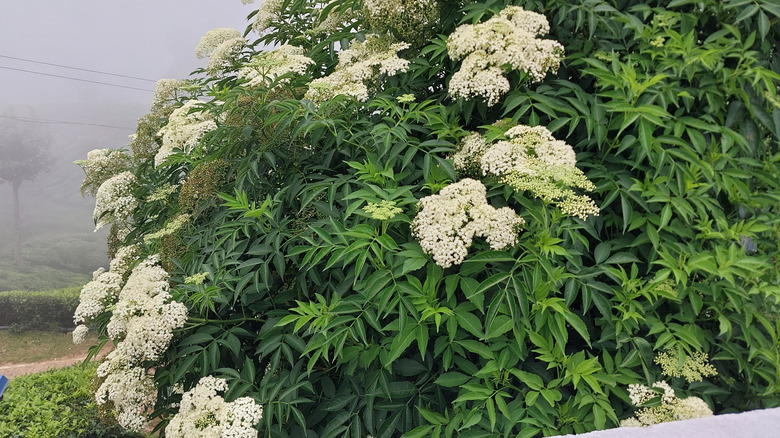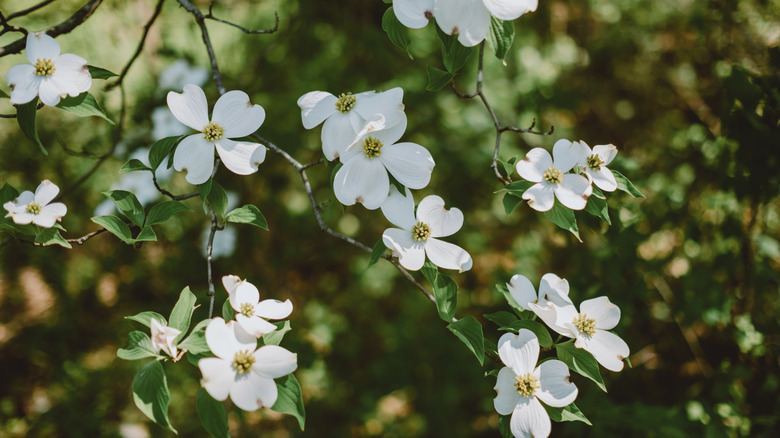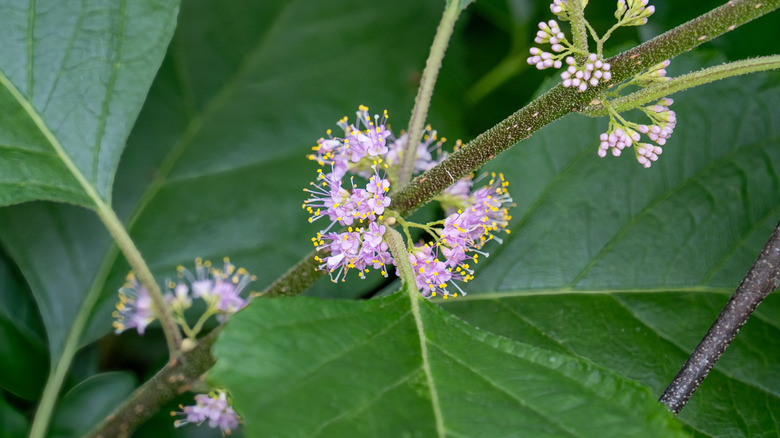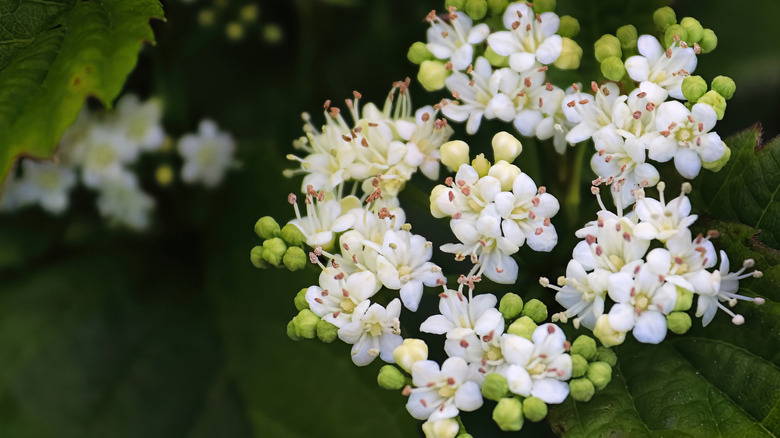16 Stunning Flowers That'll Fill Your Yard And Garden With Colorful Cardinals
If you want to fill your yard with colorful, red-feathered visitors year-round, it's important to choose the right plants. Northern cardinals are one of the most beloved backyard birds that nearly anyone can point out, especially the male red birds with the bright red plumage that looks striking against the foliage as they fly by. Because this beautiful species doesn't migrate, you can enjoy their beauty year-round, especially if you make your yard a bird-friendly paradise with their favorite flowering plants.
So, how do you create an environment that cardinals can't resist? Although feeders are a great way to lure in more birds, they can be big disease spreaders, and they tend to require a lot of upkeep to keep them clean. Plus, offering natural food sources isn't just better for the birds, but it's also more rewarding. When choosing the best flowers to attract cardinals, focus on what will actually draw them in, whether it's seeds, fruit, or dense branches for shelter. If possible, include a mix of varieties so there's always something available to meet their needs. The more diverse your plants are, the more likely you are to enjoy cardinal visits all year long. To help you get started, we've rounded up a few cardinal favorites that are sure to fill your yard with flashes of red in no time.
Sunflower
You may have noticed that sunflower seeds are one of the most common ingredients in bird seed, and there's a reason why. Several songbirds, including cardinals, have short, thick, slightly curved beaks that are built to crack open the tough shells, so they naturally gravitate to them. Sunflowers (Helianthus annuus) aren't just stunning, they're also larval hosts to the silvery checkerspot butterfly, giving cardinals protein-rich caterpillars to feed their young. These showy yellow flowers thrive in USDA Hardiness Zones 2 though 11 and are easily grown in well-drained soil and full sun.
Safflower
Safflower seeds are one of the best bird foods to keep feathered friends happy in winter, so why not add a few safflowers (Carthamus tinctorius) to your garden? In summer, these thistle-like plants produce showy, reddish-orange blooms. As the flowers fade, they're replaced by seed heads that can contain up to 100 seeds each. These make the perfect snack for cardinals, chickadees, house finches, nuthatches, and several other birds, while problematic species like grackles and starlings dislike them. Hardy in zones 3 to 10, safflowers thrive in rich soil in full sun.
Purple coneflower
With colorful, daisy-like blooms, purple coneflower (Echinacea purpurea) is a popular summer-blooming perennial that'll have cardinals flocking to your yard. By late summer, its abundance of seeds becomes a favorite snack of cardinals and other songbirds looking for nutrient-rich food. Additionally, this showy native supports butterfly and moth larvae, giving the red birds even more of a reason to stop by. To care for coneflowers, all you'll need is a well-draining site that gets plenty of sun. You can grow coneflowers in Zones 3 to 8, where they'll return year after year.
Pennsylvania smartweed
Pennsylvania smartweed (Persicaria pensylvanica) is a stunning, lesser-known flower that's worth growing in your garden if you want to see more cardinals. It's pink or burgundy flower spikes appear in summer, offering a rich source of nectar for pollinators like bees and butterflies. By late summer, cardinals and other birds will stop by to munch on the seeds. There are plenty to go around, as it's not uncommon for a single plant to produce over 19,000 seeds. This annual wildflower is hardy in Zones 3 to 8 and grows best in moist, well-drained soil in full sun.
Sweet pea
Sweet peas (Lathyrus odoratus) are climbing plants you should grow on your property to bring in more cardinals and fill the air with a sweet, honey-like fragrance. They bloom for several weeks in spring and summer before forming seed pods that draw in beautiful cardinals. They're hardy in Zones 2 to 10, growing well in full sun in cooler climates or afternoon shade in warmer regions. Plant seeds in soil that's rich in organic matter with good drainage, and apply a layer of mulch to keep the soil moist.
Blue vervain
There's no better plant to attract local insects and animals than blue vervain (Verbena hastata). In summer, this native perennial wildflower will fill your garden with showy, purplish-blue flower spikes made up of small tubular blooms. Butterflies and bees aren't the only visitors; beetles, flies, caterpillars, and other protein-rich insects will stop by, making the perfect treat for cardinals. Plus, its seeds provide even more food for cardinals and other birds when they ripen in autumn. Blue vervain is hardy in Zones 3 to 8 and grows best in moist, well-drained soil with full to partial sun.
Black-eyed Susan
To create a natural bird seed buffet, plant a few black-eyed Susan (Rudbeckia hirta) plants next to your coneflowers. Their golden, daisy-like blooms don't just complement the purple coneflower hues, but they also have seed-packed centers that cardinals and other songbirds can't resist. Plus, they're a host to 17 butterfly and moth species, which means plenty of caterpillars for cardinals to snag during nesting season. They're another low-maintenance native wildflower that thrives in sunny spots with well-drained soil. Although sometimes mistaken for annuals, black-eyed Susans are perennials that will return the following spring in Zones 3 to 8.
Prairie wild rose
Did you know you can attract birds with rose variety plants? Prairie wild rose (Rosa arkansana) is a small native shrub that produces pretty pink flower clusters that last for several months. Once the flowers fade, the plant forms berry-like fruits, known as hips, that ripen into a bright red. Over 30 species of birds, including cardinals, rely on the rosehips for food during the fall and winter. Prairie wild rose is a low-maintenance plant that grows beautifully in Zones 3 to 8. It's drought-tolerant and thrives in full sun to partial shade.
Nasturtium
Nasturtiums (Tropaeolum majus) aren't just edible to us, but birds like them too. Although the red or orange blooms are perfect for adding color to a salad, it's the medium-sized seeds that cardinals can't get enough of. These plants are extremely low-maintenance and practically thrive on neglect. All they need is well-drained soil, even poor soil is fine, and some sunshine to grow happily. Once established, they're also drought-tolerant. As warm-season annuals, they're perennials in Zones 9 to 11 and will die back with the frost in cooler climates.
Asters
Asters are must-plant perennials for attracting birds and pollinators. There are 186 species to choose from, and their starry, daisy-like flowers come in a range of shades, including purple, red, blue, yellow, and pink. As their blooming season winds down in the fall, asters begin producing seeds that attract cardinals, chickadees, goldfinches, and other feathered friends. They're also a host to over 100 species of butterfly and moth caterpillars, offering another food source even after all the seeds are eaten. These plants are hardy in Zones 4 to 8, and each species has its own soil and sun requirements.
Highbush blueberry
Blueberries may be a favorite summer fruit for humans, but birds are just as obsessed with these native shrubs. Highbush blueberries (Vaccinium corymbosum) stay attractive throughout the seasons, starting with their pinkish or white urn-shaped flowers in spring. At this time, cardinals will sometimes nest in the branches. The blueberries start to ripen in summer, so make sure you save some for cardinals, robins, catbirds, towhees, and other colorful songbirds. In autumn, the leaves fade to a brilliant red. Hardy in Zones 3 to 8, plant highbush blueberries in well-drained, acidic soil in partial to full sun.
Southern spicebush
Southern spicebush (Lindera melissifolia) is another gorgeous native flowering shrub that attracts cardinals and other birds. Its small, pale yellow blooms emerge in spring, attracting insects that serve as early-season protein for cardinals. On female plants, red berries appear that may be too spicy for us, but cardinals love their flavor. These gorgeous flowering shrubs thrive in shade, making them perfect for planting underneath tall trees. Southern spicebush is hardy in coastal Zones 6 to 9 and naturally grows in swampy areas, so they don't mind occasional flooding.
American elderberry
Known for their dense clusters of fragrant white flowers, American elderberries (Sambucus canadensis) are a must-have if you want to see more birds in your yard. In late summer to fall, they produce groups of nutritious fruit that are a favorite of cardinals and other birds. Plus, their pretty flowers lure in a variety of insects for the red birds to snack on. Hardy in Zones 4 to 8, this shrub or small tree thrives in rich, slightly acidic soil in partial to full sun. Regular moisture is best, though it can tolerate occasionally dry or wet sites.
Flowering dogwood
If you want to attract more birds to your garden with a stunning tree, look no further than the flowering dogwood (Cornus florida). Aptly named, this small tree becomes covered in pink, white, or yellow blooms each spring. The bright red berries that follow in late summer are beloved by cardinals and other songbirds. At this time, the foliage will change to fiery autumn colors. As an understory tree, it does well in partial shade, especially during hot, sunny afternoons, and prefers organically rich, well-drained soil. It makes a stunning accent plant in Zones 5 to 9.
American beautyberry
American beautyberry (Callicarpa americana) is a beautiful plant that adds major curb appeal and invites more cardinals into your garden. By early summer, its small, bluish or purplish flowers emerge in clusters around the stems. While the blooms are beautiful, it's the late-summer berries that gardeners (and birds) can't get enough of. The vibrant purplish fruits grow in eye-catching clusters around the stems in early autumn, sometimes lasting through winter, providing northern cardinals with winter food. Beautyberry is a low-maintenance shrub that's hardy in Zones 6 to 10, preferring rich soil and full sun to partial shade.
Arrowwood viburnum
Arrowwood viburnum (Viburnum dentatum) is another stunning native shrub that acts like a bird magnet. Once its clusters of pretty white flowers fade, its showy, bluish-black fruits appear and make your yard a hotspot for cardinals. Plus, its stems provide the perfect spot for red birds to build their nests come spring. It's extremely easy to grow, only asking for a site with well-drained soil that gets plenty of sunshine. There are even compact cultivars, so nearly anyone in Zones 2 to 8 can enjoy these beauties.
